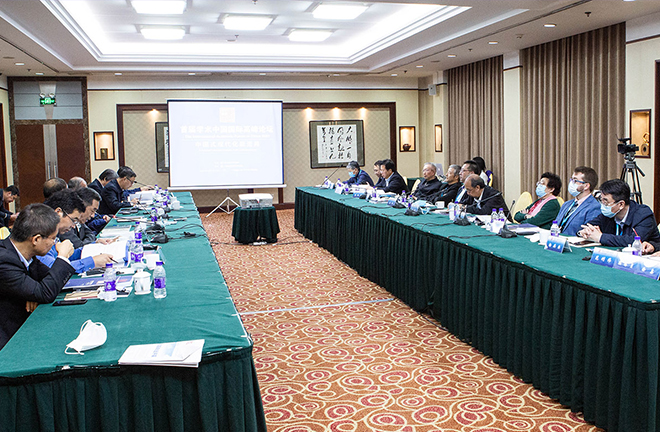Modernization in views of literary scholars and historians

Literary scholars and historians assemble at the Panel of Literature and History of The International Academic Forum in China 2021 on Oct. 14 and 15. Photo: Meng Fanjie/CSST
Literary scholars and historians exchange views on modernization at the Panel of Literature and History at The International Academic Forum in China 2021 on Oct. 14 and 15.
Multiple modernities
Modernization is always connected with human civilization, and it is the continuous social progress made in overcoming material and cultural-ethical backwardness, said Yu Pei, a research fellow from the Institute of World History at the Chinese Academy of Social Sciences.
In other words, we must consider the issue of modernization from the perspective of civilization. Seen from that perspective, however, the Western modernization theory is built upon Eurocentrism, in which there sets the presupposition that the East is stagnant and lagging and the West is advanced and developed, thus equating modernization with Westernization. The theoretical model and mentality of Western modernization are based on the premise that “taking the modernization road is equivalent to taking the Western road and the Western model,” holding that other countries should choose the same road and model, yet the Western modernization theory is not suitable for China. Yu pinpointed the crux of Western theories that regards Westernization as the single mode of modernization.
Wang Hui, director of the Tsinghua Institute for Advanced Study in Humanities and Social Sciences, mentioned the concept of “synchronicity,” which helps understand phenomena occurring in the 20th century. The concept of “synchronicity” means that the process of world history in the 20th century took place across the globe, since we are used to focusing on developed countries, imperialist powers, or major countries.
Beyond the vision of Eurocentrism, Wang saw a succession of phenomena within human civilization that occurred simultaneously in the world, which rewrote the 20th century and laid a new beginning for the 21st century. Particularly, his statement about the changes in the periphery driving the reconstruction of the entire world structure is of significance, commented Zhou Xian, a professor from the School of Arts at Nanjing University.
Zhou introduced the inspiring concept of “multiple modernities,” proposed by the Israeli sociologist S. N. Eisenstadt, who believed that modernity started from the Axial Age and thus viewed the major civilizations at the time as a background for overall modernity. In Eisenstadt’s view, throughout the entire history of world civilization, every nation has strived to revive its own nation at different times. According to his theory, the origins of world civilization are diverse, so the paths of world modernity must be diverse. Not all Western scholars stand at a Western-centric position, and their understanding of world civilization also varies, Zhou noted.
Han Dongyu, vice president of Northeast Normal University, noted that Eurocentrism is a problem we have encountered from the very beginning when engaged in world history research. It also exists in studies of traditional Chinese history, especially in the field of modern Chinese history.
Modern Chinese literature and art
Nan Fan, president of the Fujian Academy of Social Sciences, discussed the formation of modern literary concepts from four theoretical resources—the theoretical expansion brought about by the connection of different knowledge systems, the inheritance of the traditional thoughts of pragmatism, the re-understanding of literary language, and the entry of narrative style into the center of the literary field.
“Nan Fan inserts literature into the concept of modernity, as Chinese literature in the classical era was totally different from the literature we speak of today,” Zhou noted.
“In the process of China’s moving toward modernization and globalization, the influential works that mark the height of literary creations are native-soil fiction,” said Chen Xiaoming, former director of the Department of Chinese Language and Literature at Peking University.
China’s realism is naturally fused with its national style, national manner, and traditional resources. Impacted by realism, Chinese narrative literature since the 1990s has awakened the long-term memory of the nation, gradually forming a literary expression method linked to its millennial traditions, Chen noted.
Right now, literary and artistic creations have shown the tendency of pan-entertainment and amusing ourselves to death, which requires contemplation of its impact on the tasks of ideological enlightenment and national salvation, warned Zhang Fugui, director of the Institute of Chinese Culture at Jilin University. As the current popular cultural discourse is indeed highlighted, will the enlightenment task be weakened by these pan-entertainment tendencies and trends? An era of national entertainment is by no means a high-spirited era. Generally, national narrative is the modern narrative subject in modern literature.
“We need to ponder over the ways that keep the historical narrative theme of national salvation and ideological enlightenment away from interruption in an entertainment-oriented tide,” Zhang noted.
Edited by YANG LANLAN
